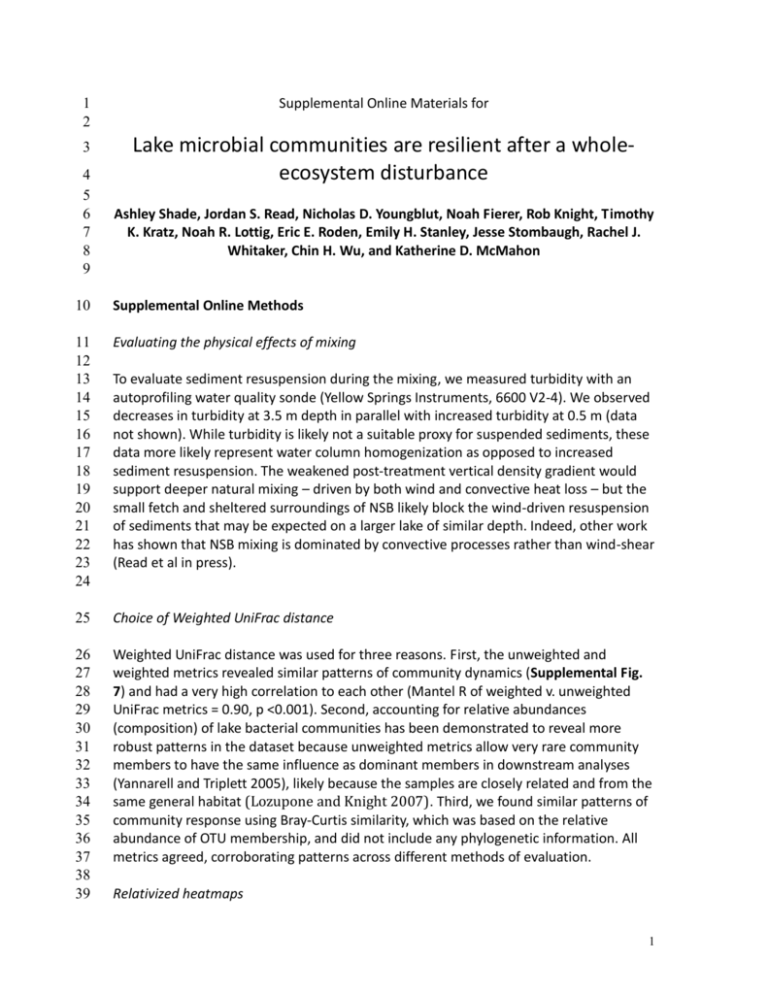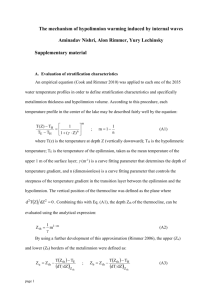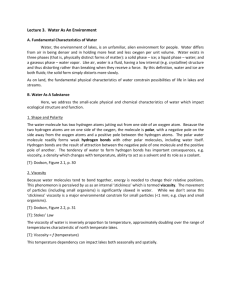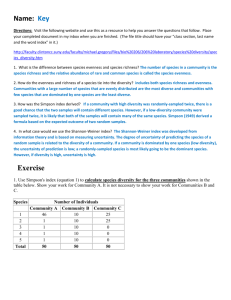Supplemental Online Materials for Lake microbial communities are
advertisement

1 2 Supplemental Online Materials for 3 Lake microbial communities are resilient after a wholeecosystem disturbance 4 5 6 7 8 9 Ashley Shade, Jordan S. Read, Nicholas D. Youngblut, Noah Fierer, Rob Knight, Timothy K. Kratz, Noah R. Lottig, Eric E. Roden, Emily H. Stanley, Jesse Stombaugh, Rachel J. Whitaker, Chin H. Wu, and Katherine D. McMahon 10 Supplemental Online Methods 11 12 13 14 15 16 17 18 19 20 21 22 23 24 Evaluating the physical effects of mixing 25 Choice of Weighted UniFrac distance 26 27 28 29 30 31 32 33 34 35 36 37 38 39 Weighted UniFrac distance was used for three reasons. First, the unweighted and weighted metrics revealed similar patterns of community dynamics (Supplemental Fig. 7) and had a very high correlation to each other (Mantel R of weighted v. unweighted UniFrac metrics = 0.90, p <0.001). Second, accounting for relative abundances (composition) of lake bacterial communities has been demonstrated to reveal more robust patterns in the dataset because unweighted metrics allow very rare community members to have the same influence as dominant members in downstream analyses (Yannarell and Triplett 2005), likely because the samples are closely related and from the same general habitat (Lozupone and Knight 2007). Third, we found similar patterns of community response using Bray-Curtis similarity, which was based on the relative abundance of OTU membership, and did not include any phylogenetic information. All metrics agreed, corroborating patterns across different methods of evaluation. To evaluate sediment resuspension during the mixing, we measured turbidity with an autoprofiling water quality sonde (Yellow Springs Instruments, 6600 V2-4). We observed decreases in turbidity at 3.5 m depth in parallel with increased turbidity at 0.5 m (data not shown). While turbidity is likely not a suitable proxy for suspended sediments, these data more likely represent water column homogenization as opposed to increased sediment resuspension. The weakened post-treatment vertical density gradient would support deeper natural mixing – driven by both wind and convective heat loss – but the small fetch and sheltered surroundings of NSB likely block the wind-driven resuspension of sediments that may be expected on a larger lake of similar depth. Indeed, other work has shown that NSB mixing is dominated by convective processes rather than wind-shear (Read et al in press). Relativized heatmaps 1 1 2 3 4 5 6 7 8 9 10 11 12 13 14 15 16 17 18 19 20 21 22 23 24 25 26 27 28 29 30 31 32 33 34 35 36 37 38 39 40 41 To observe change relative to the total abundance of the phylum, we divided the number of reads per phylum per time point by the total number of reads observed (across the time series) for that phylum to create a heatmap using the heatmap2 function from the gtools package. Heatmaps of environmental sensor observations were created in Matlab. Re-sampling richness and evenness in the epilimnion and hypolimnion We performed simulations of community richness and evenness to determine the whether it was possible to observe the day Mix community at random, given the premixing epilimnion and hypolimnion composition sampled in different contributions ("mixing scenarios", for instance 10% epilimnion/90% hypolimnion OTUs). ARISA fingerprints were used for this analysis because they were from integrated epilimnion and integrated hypolimnion samples, both together comprising the entirety of the vertical water column. First, we calculated the actual richness (number of OTUs) and Pielou's evenness from the ARISA data for the day prior to mixing (day -10), and the day of complete mixing (Mix). These values are reported in Supplemental Table 3 (and designated by the red dashed lines in Supplemental Figures 4a-4d). To perform the re-sampling, we made a vector of OTU IDs for each starting community sample: epilimnion day -10, hypolimnion day -10, epilimnion Mix, and hypolimnion Mix. In this vector, every OTU ID was represented in the same proportion as its relative abundance in the ARISA profile. (e.g., if OTU 100 had 0.50 relative abundance in the sample, it was OTU ID 100 was represented 50 out of 100 times in the vector of IDs). Then, we sampled the vector of IDs in the proportion appropriate to the mixing scenario tested. For instance, if the epilimnion was contributing 10% to the mixing scenario, we randomly sampled 10% of the epilimnion OTU ID vector to generate a cohort of IDs to "mix" with a sample of 90% of the hypolimnion OTU IDs. We performed sampling without replacement to control the underlying structure of prevalent and rare members in the community. This sampling was performed 1000 times for every mixing scenario, and a simulated richness and evenness value was calculated from the combined ("mixed") epilimnion and hypolimnion simulated community. Thus, there were 1000 simulated richness and evenness values for each mixing scenario tested. From these 1000 calculations, we asked how often we observed the actual richness and evenness values, and calculated a p-value based on how many times out of 1000 samplings we observed the real value. If the lake had mixed in one of the tested scenarios, we would expect that the p-value would not be significant (e.g. one would observe often at random the exact values that we observed in the actual mixed lake communities). This process allowed us to determine the likelihood that the observed communities were purely the result of physical displacement of cells in the integrated water column. 2 1 2 3 Supplemental Table 1. Physical and chemical characteristics of North Sparkling Bog, Vilas County, Wisconsin. Parameter Surface area Mean depth Maximum depth Light attenuation Dissolved organic carbon Mixing regime pH Total phosphorus Total nitrogen Chorophyll Value 0.47 ha 2.28 m 4.5 m 1.4- 2.4 m 9.5 mg/L dimictic 5.2 25.4 g/L 691.9 g/L 27.5 g/L 4 5 3 1 2 3 Supplemental Table 2. Richness and evenness calculated from ARISA fingerprints of microbial communities from integrated epilimnion and integrated hypolimnion samples. Epilimnion Hypolimnion Day -10 Day Mix Day -10 Day Mix ARISA richness (no. OTUs) ARISA Pielou's evenness 44 44 59 42 0.817 0.851 0.851 0.841 4 5 4 1 Supplemental Figures 2 3 4 5 6 7 8 9 Supplemental Figure 1. Weighted UniFrac distances between each July time point and the day before the mixing manipulation began, day -9. (a) Epilimnion (0 m) UniFrac distances. (b) Hypolimnion (4 m) UniFrac distances. The red line is the overall mean UniFrac distance for all possible epilimnion or hypolimnion July pairs. The dotted lines and red shading show one standard deviation from the overall mean. Pyrosequencing data were used for this analysis. 10 11 5 1 2 3 4 5 6 7 Supplemental Figure 2. Seasonal total nitrogen measurements in North Sparkling Bog from integrated epilimnion and hypolimnion water samples. The period of the mixing experiment presented was 01 to 10 July 2008 shown between the dashed lines; postmixing July dates are shaded. 8 6 1 2 3 4 5 Supplemental Figure 3. Heat map analysis to assess the relative changes of each phylum to the lake mixing. Within a phylum, abundances were relativized across time points and within a thermal layer (a) epilimnion (0 m) and (b) hypolimnion (4 m), so that the day that the maximum number of sequences recovered received a value of 1 (represented 7 1 2 3 4 5 6 7 8 by the darkest green color), allowing for evaluation of both rare and dominant community members that have similar patterns through time. The response patterns were then clustered using hierarchical clustering with average linking to reveal similar trends across phyla, as shown by the dendrograms. Pyrosequencing data were used for this analysis. On the x axis, orange circles identify the pre-mix time point (day -9), green circles identify the mixing time point (day Mix), and yellow circles identify the recovery time point (day 20). 8 1 2 3 4 5 6 7 8 9 Supplemental Figure 4a. Simulated richness based on integrated epilimnion and integrated hypolimnion ARISA fingerprints of North Sparkling Bog bacterial communities from day -10 before mixing. The red dashed line shows the actual value for epilimnion richness on the day mixing was achieved, and the histogram shows the distribution of expected richness given 1000 samplings of day -10 communities (without replacement) in the proportions provided in the label at the top of the panel. For example, the label E70H30 indicates that the epilimnion community was sampled to comprise 70% of the simulated mixed community, and the hypolimnion 30%. 9 1 2 3 4 5 6 7 8 9 Supplemental Figure 4b. Simulated richness based on integrated epilimnion and integrated hypolimnion ARISA fingerprints of North Sparkling Bog bacterial communities from day -10 before mixing. The red dashed line shows the actual value for hypolimnion richness on the day mixing was achieved, and the histogram shows the distribution of expected richness given 1000 samplings of day -10 communities (without replacement) in the proportions provided in the label at the top of the panel. For example, the label E70H30 indicates that the epilimnion community was sampled to comprise 70% of the simulated mixed community, and the hypolimnion 30%. 10 1 2 3 4 5 6 7 8 9 Supplemental Figure 4c. Simulated evenness based on integrated epilimnion and integrated hypolimnion ARISA fingerprints of North Sparkling Bog bacterial communities from day -10 before mixing. The red dashed line shows the actual value for epilimnion evenness on the day mixing was achieved, and the histogram shows the distribution of expected evenness given 1000 samplings of day -10 communities (without replacement) in the proportions provided in the label at the top of the panel. For example, the label E70H30 indicates that the epilimnion community was sampled to comprise 70% of the simulated mixed community, and the hypolimnion 30%. 11 1 2 3 4 5 6 7 8 9 10 Supplemental Figure 4d. Simulated evenness based on integrated epilimnion and integrated hypolimnion ARISA fingerprints of North Sparkling Bog bacterial communities from day -10 before mixing. The red dashed line shows the actual value for hypolimnion evenness on the day mixing was achieved, and the histogram shows the distribution of expected evenness given 1000 samplings of day -10 communities (without replacement) in the proportions provided in the label at the top of the panel. For example, the label E70H30 indicates that the epilimnion community was sampled to comprise 70% of the simulated mixed community, and the hypolimnion 30%. 11 12 1 2 3 4 5 6 7 8 9 10 Supplemental Figure 5. Permutated analysis of betadispersion to quantify overall variability in bacterial community composition for (a) Epilimnion and (b) Hypolimnion by month, across years. Legacy bacterial community fingerprints of integrated epilimnion and hypolimnion samples were generated using automated ribosomal intergenic spacer analysis, and the analysis was performed on Bray-Curtis similarities between samples. We detected no differences across months (all p > 0.10), demonstrating that the bacterial communities varied consistently through time despite the mixing disturbance in July 2008. 13 1 2 3 4 5 6 7 8 9 Supplemental Figure 6. Rate of compositional change (similarity-decay) for bacterial communities from June-August 2007, post-mixing July-August 2008, and June-August 2009. Sample sizes (n) for each category are at the top of the bars. Rates were calculated by regressing similarity against days between observations, where the loglinear slope is the rate. Rates are negative because they are assessed using similarity metrics (rather than dissimilarity). For all models, p < 0.001. 14 1 2 3 4 5 6 7 Supplemental Figure 7. Non-metric multidimensional scaling ordinations based on a: unweighted UniFrac distance and b: Bray-Curtis similarity for epilimnion and hypolimnion communities. The overall responses (direction and scale) of the communities are consistent across choice of similarity measure. Pyrosequencing data were used for this analysis. 15 1 2 3 4 5 6 7 8 9 10 11 Supplemental references Lozupone C and Knight R. (2007). Global patterns in bacterial diversity. PNAS 104(27): 11436. Read JS, Hamilton DP, Desai AR, Rose KC, MacIntyre S, Lenters JD, et al. (in press). Lake-size dependency of wind shear and convection as controls on gas exchange. Geophysical Research Letters. Yannarell AC and Triplett EW. (2005). Geographic and environmental sources of variation in lake bacterial community composition. Applied and Environmental Microbiology 71(1): 227-239. 16







